Bathroom Exhaust Fan Leaks Cold Air
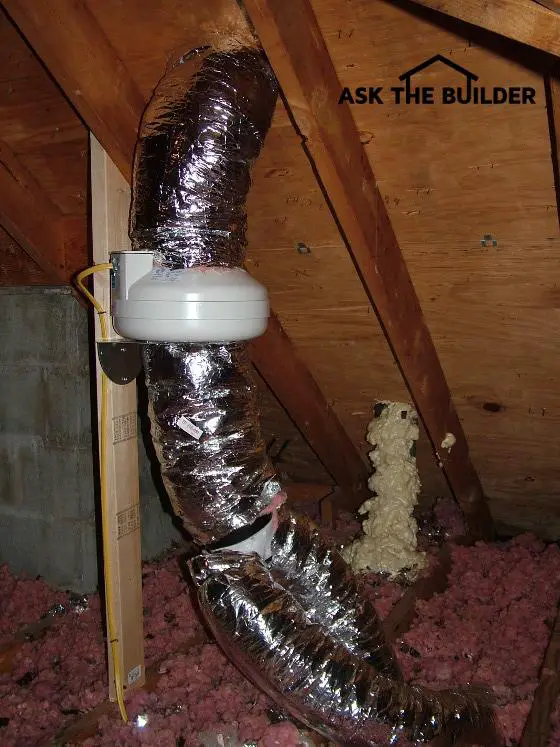
Bathroom Fan Leaks Cold Air | The off-white, overweight flying saucer is really a quiet bathroom exhaust fan. You can see the flexible insulated exhaust pipe that prevents condensation. The humid bath air goes out the roof. © 2021 Tim Carter
Bathroom Fan Leaks Cold Air TIPS
- Fan dampers meant to stop mice, not air
- NEVER install bath exhaust in an attic or under a roof overhang
- WATCH my Two VIDEOS below about bath exhaust fans
- BEST wall exhaust vent hood has a double door CLICK HERE to BUY NOW
- CLICK HERE to Get Tim's FREE & FUNNY Newsletter
I can call you on the phone to solve your bathroom fan leaking cold air problem. The call is FREE if you're not satisfied with my solution. CLICK HERE to set up the call.
DEAR TIM: My husband and I purchased a small ranch home built in the 1950s. A year ago we installed new exhaust fans in the bathrooms, kitchen, and basement. Last winter I noticed cold air would fall out of the fan covers when the fan was not operating. The small bathroom is now the coldest room in the house. Did we make a mistake? Why is cold air coming into the house? What's the best way to exhaust the air from the bathrooms? Because heating costs are rising, we must stop or minimize the cold air infiltration. Jill L-H., Maumee, OH
DEAR JILL: My gut reaction is that you did nothing wrong. My experience tells me that you probably didn't do some extra things that would have made a big difference.
Unfortunately, these extra added touches don't come as part of the written instructions with many exhaust fans. I have never seen these tips on a sheet of paper. When you install as many fans as I have, you start to learn what works best.
CLICK HERE to get FREE & FAST BIDS from a local bath-fan installer.
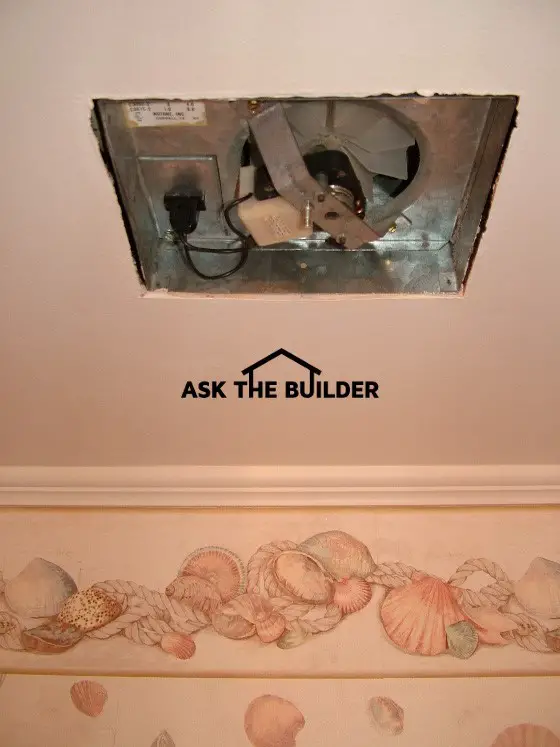
This exhaust fan has a built-in damper, but most fit poorly allowing cold air to drift back into a home. © 2017 Tim Carter
Why Do Bath Fans Leak Cold Air?
Let's briefly discuss the dynamics of what is happening with the exhaust fans. I assume you used the suggested smooth-metal piping to connect the fan to the exterior of your home. My guess is the bathroom fan exhaust pipe is located in a cold attic space.
If so, the pipe gets very cold when the fan is not in use. This cold pipe can cause the air inside the pipe to go from warm to cold.
Cold air is denser and heavier than warm air and wants to go down, not up. This is why you feel it fall down out of the exhaust fan cover.
Should Pipe Joints be Sealed?
Metal pipe joints should be sealed with special metal duct tape used by professional HVAC contractors.
Cold air from the attic can also be entering the joints in the metal piping if they are unsealed. It is an excellent idea to use aluminum duct tape that heating and cooling contractors use to seal ducts.
This is an inexpensive special tape you often can only find where furnaces, air conditioners and ductwork are sold. Do not confuse this professional tape with the common duct tape sold at home centers and hardware stores.
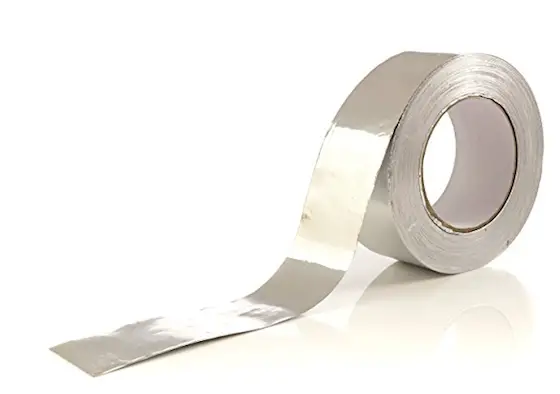
This is very cool duct tape. Pros never use the crap tape you see at home centers. This tape is thin aluminum with a strong adhesive. CLICK THE IMAGE NOW TO ORDER SOME.
Should a Bath Fan Vent Outdoors?
All bath fans should vent or exhaust to the outdoors. Never allow a bath fan to dump moist air into an attic.
Should Bath Fans Have an Internal Damper?
Bath fans should have an internal flapper damper that blocks cold air. These dampers usually fit poorly inside the fan housing and the cold air can seep by them. If you want to stop cold air, you need to have a great damper, or double damper at the exhaust hood where the air leaves your home.
Should Vent Hoods Have a Sealed Door?
Some vent hoods made by the fan manufacturers have swinging doors that have a felt seal. These are not bad. I've had decent success with these.
But the best vent hood I've ever used to stop cold air is one that exits the sidewall of your home and has a double damper. These are ingenious and inexpensive bathroom exhaust vent hoods that are very easy to install. Here's the one I have at my own home:
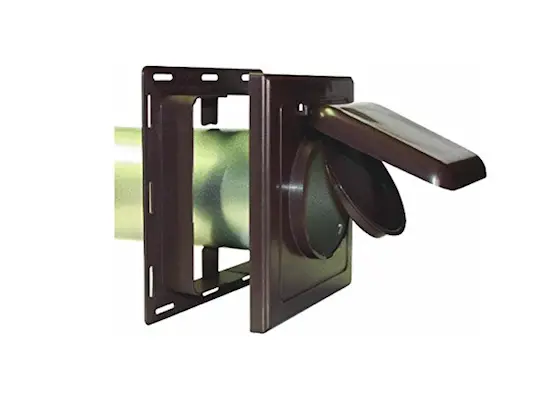
Look at the double doors. This keeps pests out and prevents cold air from backdrafting into your home. CLICK THE IMAGE to order it now.
Where Should a Bath Fan Exhaust Outdoors?
A bath fan can exhaust through the roof or you can go out a sidewall of your home.
Exhausting bath exhaust out a roof is the safest and best method. This ensures all humid air from showers and baths will never rot any wood. If you exhaust bath air under, or near, a roof overhang, the humid air can get sucked into the attic through soffit vents. This moisture can condense on the trusses, roof rafters and roof sheathing and cause wood rot and mold growth.
What Vent Flashing is Used on the Roof?
I prefer to install a roof vent that is made to compliment the high-quality exhaust fans I install. Most high-quality exhaust fans, and I've installed Fantech in my own home with great results, come with a special hood that's made to be used with shingles, shakes, or metal roofs. The Fantech exhaust fans are very quiet because you install the motor up in an attic or at some other location away from the bathroom. These fans vacuum the air out of the bathroom and you simply don't hear much noise at all.
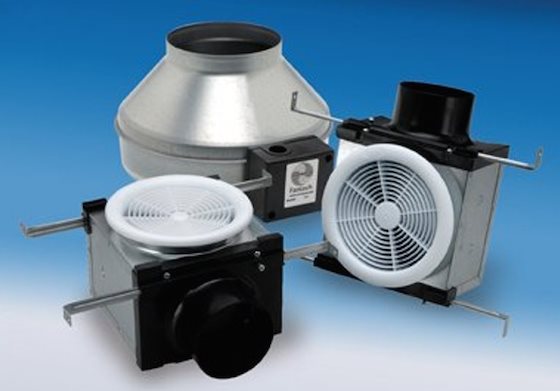
Here's a typical Fantech bath exhaust fan setup. The odd cone-shaped metal thing is the fan. The two boxes that have the round white covers are place up in the ceiling joists of the bathrooms. All you see are the sleek round white covers. They come with and without lights! I LOVED these in my last house. CLICK THE IMAGE TO BUY the SET NOW.
These self-flashing exit caps have a great flapper damper with a felt seal that really closes tightly when the fan is not in use. Virtually no air works its way back down my exhaust pipes so long as the flapper is checked annually for dirt and debris buildup.
CLICK HERE to get FREE & FAST BIDS from a bath-fan installer in your city or town.
What About Insulating Metal Exhaust Pipe?
It is also a great idea to insulate the metal pipe in any unconditioned space where it passes. If the metal pipe is not insulated, the moist humid air in the pipe will condense on the side walls. Often this water finds its way back to the fan and drips into the bathroom. Many a homeowner thinks they have a roof leak, when in fact the issue is condensation inside the pipe.
I prefer to spray the metal exhaust pipes with foam insulation. This insulation is available in aerosol cans and is quite easy to work with. Be sure to clean the exterior of the metal pipe with soap and water as the metal pipe often is coated with a fine film of oil from the manufacturing mill. Wear very old clothes when working with the spray foam. Many foams have a urethane component and if the urethane foam gets on the clothes and dries, you can't get it off.
Be sure the entire length of the exhaust pipe is insulated all the way from the fan to the underside of the roof where it exits the house. This insulation will provide a secondary benefit by preventing or minimizing condensation inside the exhaust pipe. Many people think they have a roof leak during winter months as the exhaust fans operate. In most cases the water is simply condensation that forms against the cold sidewalls of the exhaust pipe and then runs downhill back to the fan.
WATCH these Bath Fan VIDEOS:
Not all exhaust fans are created equal. Some have low-powered fans that can barely push open the first flapper damper much less the second flapper at the roof. As with many consumer products, the things that work better and are more reliable often cost more. When you shop for fans you will be shocked to discover it only costs a little more money to get a very high-quality fan.
Can I Install a Remote Fan in an Attic?
You can install a remote fan in an attic. The advantage is the fan noise is not above your head in the bathroom. The remote fan can be 10, 20, or 30 feet away from the bathroom.
If you want the best bathroom exhaust fan, I recommend you get the Fantech fan that I had in the last home I built. I loved them so much, I had two of them, one for the master bathroom and another one exhausted the air from two back-to-back bathrooms in my home.
Do I Need a Makeup of Fresh Air Intake?
Your house should also be equipped with a makeup or fresh-air intake vent. When exhaust fans, clothes dryers, central vacuum cleaners, fuel-burning furnaces and water heaters and fireplaces operate, they consume vast amounts of air. It is entirely possible that back drafting is happening in the bathroom fan exhaust pipe as it becomes the point of entry for air needed by another appliance that is sucking air from the house.
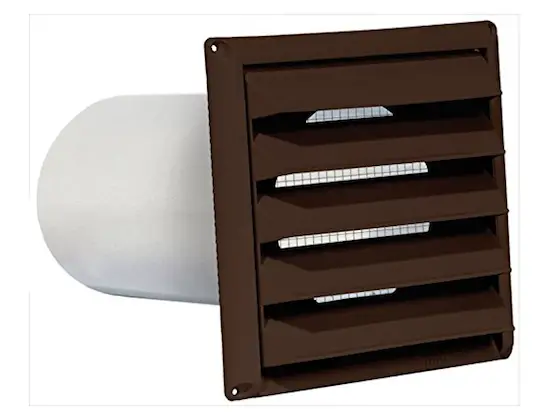
This fresh-air intake vent will do a great job. You may need several to get enough air indoors to satisfy all fuel-burning appliances. Pipe them with solid 4-inch metal pipe. CLICK THE IMAGE TO ORDER THIS VENT NOW.
Makeup air intake ports can be as simple as a clothes dryer exhaust cap that has holes drilled in the flapper. I have also seen small hoods where the flapper is removed and small galvanized hardware cloth is inserted in its place. These makeup air intake points should be located in the utility room where furnaces and water heaters are located.
CLICK HERE to get FREE & FAST BIDS from a bath-fan installer in your city or town.
Column 594
24 Responses to Bathroom Exhaust Fan Leaks Cold Air